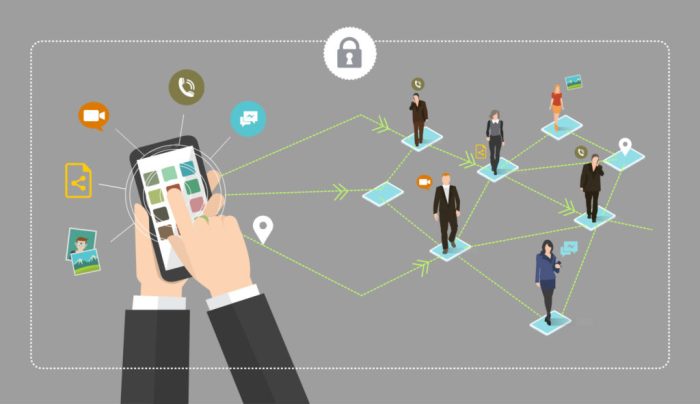Instant messaging overtakes SMS texts for the first time – a seismic shift in communication! Remember those days of painstakingly crafting 160-character masterpieces? Now, emojis reign supreme, GIFs fly, and group chats explode with activity. This isn’t just a technological upgrade; it’s a cultural revolution, reshaping how we connect, share, and even think. We’re diving deep into this digital transformation, exploring its impact on everything from telecom giants to our own social lives.
From the humble beginnings of SMS to the explosive growth of platforms like WhatsApp, Messenger, and iMessage, this journey reveals a fascinating story of technological innovation and evolving user behavior. We’ll unpack the key factors driving this monumental shift, examining the features that made instant messaging so irresistible and the consequences – both positive and negative – of its rise to dominance.
User Preferences and Behavior Shifts
The rise of instant messaging (IM) surpassing SMS signifies a profound shift in how we communicate. This transition isn’t merely about technological advancement; it’s a reflection of evolving user preferences and behaviors, driven by factors ranging from cost-effectiveness to the sheer richness of features offered by modern IM platforms. Understanding these shifts is key to comprehending the changing digital landscape.
The preference for instant messaging over SMS is not uniform across all demographics. Younger generations, particularly millennials and Gen Z, overwhelmingly favor IM apps. This is largely due to their familiarity with mobile technology and their inherent preference for visually-rich communication styles, which IM platforms excel at. Older demographics, however, may still retain a stronger preference for SMS, possibly due to familiarity, simpler interface or less dependence on data connectivity.
Factors Influencing User Preference for Instant Messaging
Several key factors contribute to the widespread adoption of instant messaging apps. Cost is a significant one; most IM platforms are free, relying on advertising or premium features for revenue, unlike SMS which often involves per-message charges. Beyond cost, the feature set of IM apps is considerably richer. They often include features like group chats, file sharing (images, videos, documents), voice and video calls, and even integrated payments, offering a far more versatile communication experience than SMS. Convenience also plays a major role; IM apps are typically integrated into existing social media ecosystems, making them easily accessible and seamlessly integrated into users’ daily routines. The instantaneity of IM is also appealing; messages are delivered and received almost instantaneously, unlike SMS which can sometimes experience delays.
Examples of Changed User Behavior, Instant messaging overtakes sms texts for the first time
The shift from SMS to IM has led to observable changes in user behavior. For instance, the prevalence of group chats for coordinating events, sharing information, or simply casual conversation has exploded. The ease of sharing multimedia content via IM has also transformed how people express themselves and interact, leading to a more visually-driven communication style. Furthermore, the integration of IM into various platforms (work, social, gaming) has blurred the lines between different aspects of life, making communication more fluid and integrated. Consider the rise of ephemeral messaging features – like disappearing messages – which prioritize privacy and spontaneity, behaviors largely absent in traditional SMS communication.
Comparative Analysis of User Engagement Metrics
While precise, universally available data comparing SMS and IM engagement metrics is difficult to obtain due to the proprietary nature of much of this information, observable trends suggest a significant shift. IM platforms typically boast higher daily and monthly active users, longer session durations, and a greater volume of messages exchanged. SMS usage, while still prevalent in certain sectors (e.g., transactional messaging), shows signs of stagnation or decline in overall user engagement compared to the exponential growth seen in major IM platforms. This difference reflects the richer, more interactive experience offered by IM apps, encouraging higher levels of user engagement and interaction. The sheer number of features, the ease of use, and the integrated nature of IM apps all contribute to higher user engagement.
Features and Functionality Comparison
The rise of instant messaging (IM) over SMS isn’t just about convenience; it’s a seismic shift in how we communicate. This change is driven by a fundamental difference in features, functionality, and the overall user experience. Let’s delve into a detailed comparison to understand why IM has become the dominant force.
Core Feature Differences Between Popular Instant Messaging Platforms
Instant messaging platforms, while sharing the basic function of real-time text communication, offer a wide spectrum of features. WhatsApp, for example, excels in its simplicity and widespread adoption, while Telegram prioritizes security and advanced features like channels and bots. Facebook Messenger leverages the social graph of Facebook, facilitating seamless communication within existing social networks. Each platform caters to different needs and preferences, influencing user adoption. These differences extend beyond basic text messaging to include features like voice and video calls, file sharing, group chats, and more.
Data Usage, Security Protocols, and Cost Structures
The cost of using these platforms varies significantly. While SMS typically involves per-message charges from your mobile carrier, most IM apps are free to use, relying on data usage instead. This data usage can vary depending on the features used; a video call will consume considerably more data than a text message. Security protocols also differ. WhatsApp, for instance, employs end-to-end encryption, ensuring only the sender and recipient can read messages. Other platforms may have varying levels of encryption, impacting user privacy and data security. Understanding these differences is crucial for choosing the platform that best aligns with your needs and priorities.
Comparative Analysis of SMS and Instant Messaging
| Feature | SMS | Instant Messaging | Comparative Notes |
|---|---|---|---|
| Cost | Typically charged per message by carrier. | Generally free, but relies on data usage. | IM offers significant cost savings for high-volume users. |
| Data Usage | Relatively low data usage per message. | Can vary greatly depending on features used (text, voice, video). | IM’s higher potential data usage is offset by its richer feature set. |
| Security | Security measures vary by carrier, generally less robust than IM options. | Many platforms offer end-to-end encryption (e.g., WhatsApp, Signal). | IM often provides stronger security features, protecting user privacy. |
| Features | Limited to text messages, occasionally MMS (multimedia messaging service). | Offers a wide range of features including voice and video calls, file sharing, group chats, and more. | IM’s feature-rich environment enhances communication possibilities. |
Innovative Features in Instant Messaging
The feature set of instant messaging platforms extends far beyond the capabilities of SMS. For example, features like ephemeral messages (messages that disappear after a set time), read receipts, and the ability to share location data in real-time, are not available in standard SMS. The integration of bots for automated tasks, the creation of group chats with hundreds of participants, and the ability to make high-quality voice and video calls are all testament to the innovative advancements in IM technology. These features have fundamentally changed how we interact, making communication more efficient, engaging, and versatile. Consider the impact of group video calls during the pandemic; this feature became indispensable for maintaining social connections and facilitating remote work.
Future Trends and Predictions: Instant Messaging Overtakes Sms Texts For The First Time
The reign of instant messaging is only just beginning. Its overtaking of SMS signals a fundamental shift in how we communicate, and the future holds even more dramatic changes. We’re moving beyond simple text-based chats towards a richer, more integrated communication ecosystem, blurring the lines between messaging, social media, and even the metaverse.
The convergence of instant messaging with other platforms will be a defining characteristic of its future evolution. We’re already seeing hints of this with features like integrated video calls, file sharing, and the ability to seamlessly connect with other apps. This trend will only accelerate, leading to a more streamlined and integrated communication experience.
Increased Integration with Other Platforms
Imagine a world where your instant messaging app is the central hub for all your online interactions. This isn’t science fiction; it’s a realistic near-future scenario. Think about scheduling appointments directly within a chat, making online purchases through integrated e-commerce platforms, or collaborating on documents in real-time without leaving the messaging app. This level of integration will dramatically increase efficiency and simplify our digital lives, much like how WeChat has already achieved a high level of integration in China. The seamless connection between various platforms will create a more cohesive and user-friendly digital experience. For example, a user could book a flight through a travel agency’s integrated chatbot within their messaging app, receive confirmation updates, and then share the itinerary directly with friends and family—all without ever leaving the app.
Advanced AI-Powered Features
Future instant messaging platforms will leverage artificial intelligence in unprecedented ways. Real-time translation will become increasingly accurate and seamless, breaking down language barriers and fostering global communication. AI-powered assistants will proactively manage notifications, summarize lengthy conversations, and even suggest relevant responses, enhancing productivity and reducing information overload. We can envision an AI that can automatically create meeting summaries from a group chat, or even translate a message into multiple languages simultaneously for a diverse group of friends. This goes beyond simple autocorrect; it’s about intelligent assistance that understands context and anticipates user needs.
The Metaverse and Immersive Messaging
The metaverse presents a fascinating opportunity to revolutionize instant messaging. Imagine interacting with friends and family as 3D avatars in a shared virtual space, enhancing communication with richer nonverbal cues and immersive experiences. This isn’t just about video calls; it’s about creating shared virtual environments where users can collaborate, play games, and socialize in a more engaging way. Think of shared virtual workspaces where teams can brainstorm together in a realistic digital environment, or virtual concerts where users can interact with performers and other attendees as avatars. This level of immersion will transform how we connect with others online.
Enhanced Security and Privacy Features
With increased reliance on instant messaging, security and privacy will become paramount. Future platforms will incorporate advanced encryption techniques, offering users greater control over their data and communication. End-to-end encryption will become the standard, ensuring that only the sender and recipient can access messages. Furthermore, robust mechanisms for verifying identities and preventing impersonation will be crucial to maintaining trust and security. Features like disappearing messages and granular control over data sharing will empower users to protect their privacy in an increasingly digital world. This will require a proactive approach from developers, working in conjunction with security experts to stay ahead of emerging threats and build robust security protocols.
The reign of SMS is over, and the era of instant messaging is in full swing. This transition isn’t just about faster communication; it reflects a profound change in how we interact, build relationships, and consume information. While the future of communication remains unwritten, one thing’s certain: the speed, versatility, and rich features of instant messaging have fundamentally altered the landscape, and its influence will only continue to grow. Get ready for the next chapter.
 Invest Tekno Berita Teknologi Terbaru
Invest Tekno Berita Teknologi Terbaru

